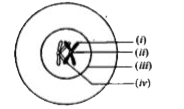Regarding mutation select how many points are correct ?
(i) Random
(ii) Discontinuous
(iii) Continuous
(iv) Directionless
Two
Three
Four
Five
The correct Answer is:B
To solve the question regarding mutations, we need to evaluate each of the given statements and determine how many of them are correct.
Step 1: Analyze the Statements
1. Random: Mutations occur randomly. They can happen at any time and in any location within the DNA sequence. This statement is correct.
2. Discontinuous: Mutations are not a continuous process; they occur at specific points in the DNA sequence rather than spreading continuously throughout. This statement is correct.
3. Continuous: This statement suggests that mutations occur continuously, which contradicts the previous analysis. Therefore, this statement is incorrect.
4. Directionless: Mutations can occur in any direction within the DNA sequence, meaning they are not limited to a specific direction. This statement is correct.
Step 2: Count the Correct Statements
From the analysis:
- Correct statements: Random, Discontinuous, Directionless
- Incorrect statement: Continuous
Thus, there are three correct points regarding mutations.
Final Answer
The correct number of points regarding mutations is 3.
---
2. Discontinuous: Mutations are not a continuous process; they occur at specific points in the DNA sequence rather than spreading continuously throughout. This statement is correct.
- Correct statements: Random, Discontinuous, Directionless
- Incorrect statement: Continuous
Similar Questions
Knowledge Check
Which of the following factors affect human health ?
(i) Infections
(ii) Silent mutations
(iii) Life style
(iv) Genetic disordersA(i)m (ii) and (iv)B(i) and (ii)C(i), (iii) and (iv)D(i), (ii), (iii) and (iv)Select the correct option representing the excretory organs present in (i) earthworm, (ii) centipede, (iii) prawn, and (iv) flatworm.
A(i)(ii)(iii)(iv)Malpighian tubulesFlame cellNephridiaGreen glandsB(i)(ii)(iii)(iv)Flame cellGreen glandMalpighian tubulesNephridiaC(i)(ii)(iii)(iv)NephridiaMalpighian tubulesGreen glandFlame cellD(i)(ii)(iii)(iv)Green glandNephridiaFlame cellMalpighian
Mutations as proposed by Hugo de Vries are
(a) Small and directional
(b) Gradual and continuous
(c) Random and directionless
(d) Large and directional
View SolutionRead the following statements and select the incorrect statements .
(i) The cytoplasmic increase is not a discontinuous process
(ii) The cell cycle is not a genetically controlled process
(iii) Synthesis phase synthesizes cell organelles only
(iv) Interphase is not metabolically inactive
View SolutionRead the following and select the correct option :
A. Carnivora is a/an (i) that involves (ii) and Canidae.
B. Petunia and (iii). belongs to Family (iv)
View SolutionIdentify and select the correct match of columns I , II and III
View SolutionLabel the parts (i), (ii), (iii) and (iv)

View SolutionSelect correct features for Pinus.
(i) Monoecious plant (ii) Pinnate leaves
(iii) Sunken stomata (iv) Heterosporous
View Solution
